Introduction
While I am writing this, markets are panicking.
Volatility, as measured by the CBOE Volatility Index, has spiked to more than 40, the highest number since 2020, when the world was hit by bad news from Wuhan, China (pandemic).
Bloomberg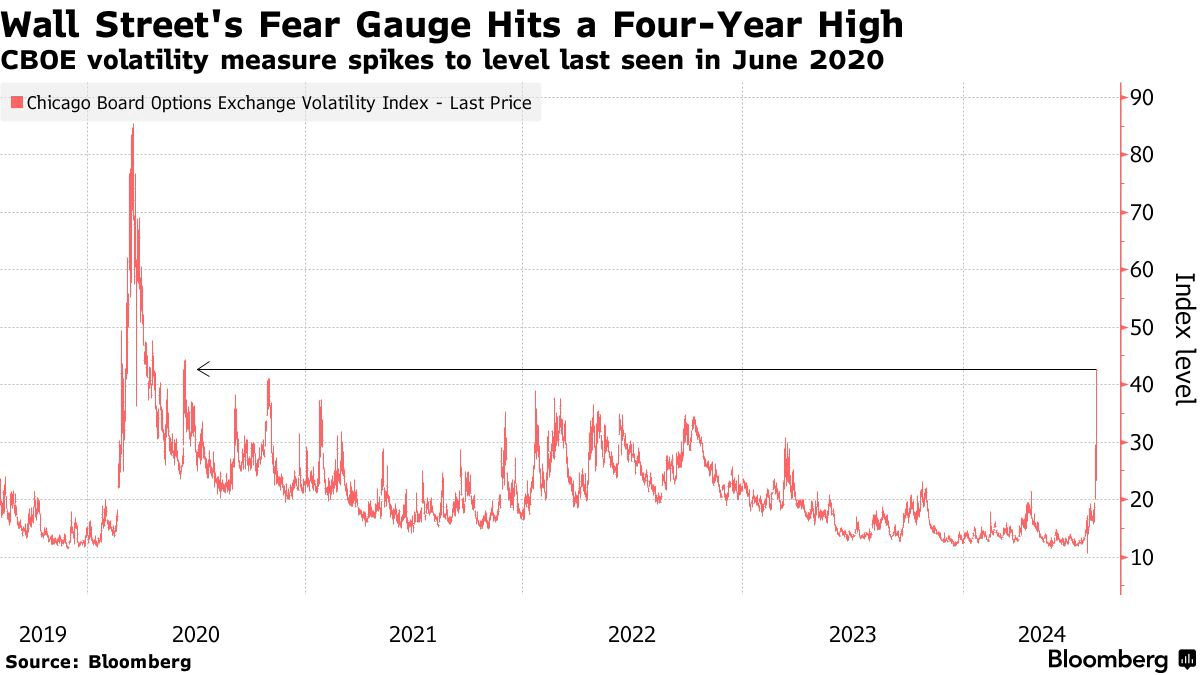
This is the result of a number of headwinds, including poor economic growth in the United States, an unwinding carry trade that involves the Japanese yen, geopolitical uncertainty, and the fact that tech stocks are still trading at a lofty valuation.
I added emphasis to the quote below:
Markets are extending last week’s retreat, when a weak US jobs report ignited fears that the Fed isn’t moving fast enough to prevent a sharp economic downturn. The wave of selling hit a fever pitch in Japan as traders rushed to unwind popular carry trades, powering a 3% surge in the yen and causing the Topix stock index to shed 12% and close the day with the biggest three-day drop in data stretching back to 1959.
The key point is the current shift in narrative, from no landing to soft landing,” said Florian Ielpo, the head of macro research at Lombard Odier Asset Management. “That risk was poorly priced and investors shifting gears fast explains the extent of the move.” – Bloomberg
With that said, for some companies, higher volatility is a blessing. One of these companies is Cboe Global Markets (BATS:CBOE), a company I called “One Of The Best Compounders In Finance” in my March 10 article.
Since then, shares have returned 4.6%, which is in line with the return of the S&P 500.
In this article, I’ll update my thesis on the company behind the CBOE VIX index and explain why I continue to believe it’s one of the best dividend growth stocks in the market – not just in finance.
So, let’s dive into the details!
What’s Cboe?
Did I ever mention I love stock exchanges?
That’s a rhetorical question, as I have covered two of Cboe’s biggest peers in recent weeks in very bullish articles (here and here).
A few years ago, a very wealthy fund manager said that owning Cboe (and its peers) is like owning a money printer. Whenever someone places a trade on one of its exchanges, shareholders make money.
The higher the volatility, the better.
Founded in 1937, Chicago-based Cboe owns the Chicago Board Options Exchange and the exchange operator BATS Global Markets.
Cboe Global Markets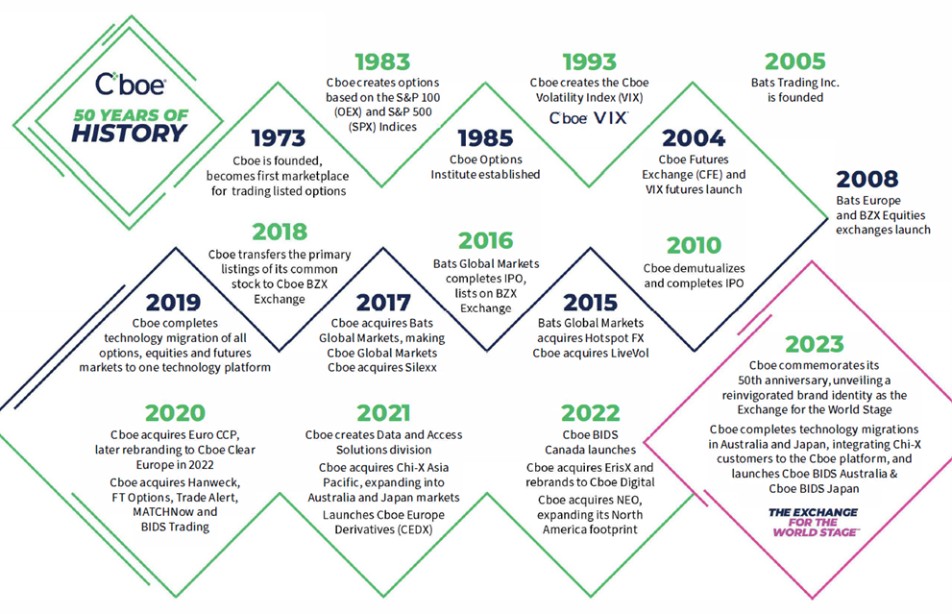
Here’s a list of the company’s biggest operations – based on its 10-K:
-
Options Exchange: Cboe operates the largest options exchange in the U.S., which offers a wide range of options trading services.
-
Stock Exchange Operator: Cboe is the third-largest stock exchange operator in the U.S.
-
Cboe Europe: The company owns one of the largest stock exchanges by value traded in Europe.
-
Cboe Clear Europe: This is a clearinghouse that provides pan-European equities and derivatives clearing services.
-
BIDS Holdings: The company owns a leading block-trading ATS (Alternative Trading System) in the U.S. and offers block-trading services in Europe, Canada, Australia, and Japan through Cboe market operators.
It also owns trading venues in Australia and Japan, a digital asset spot market and future exchange, a clearinghouse for digital assets, and a Canadian securities exchange.
The company also has major licensing deals with companies like S&P Global (SPGI), MSCI (MSCI), and others and works with a wide range of institutions, trading platforms, and professional traders.
And while its revenue is impacted by major M&A deals, it’s fair to say that upswings in volatility are highly favorable for the company (see below).

Right now, this business model is firing on all cylinders.
Cboe’s Is All About Capturing Market Share
A few days ago, Cboe reported its 2Q24 earnings, which saw a 10% year-over-year increase in revenue to more than $510 million. This paved the road for a 21% increase in adjusted earnings per share to $2.15.
Cboe Global Markets
As we can see in the overview above, the Cash and Spot Markets category saw a 15% year-over-year revenue increase. Meanwhile, the Derivatives segment saw an 11% rise in organic net revenue.
Moreover, the company’s proprietary index option and futures products, especially the S&P 500 Index option (“SPX”) and the Volatility Index, saw increased trading volumes. This is measured by average daily volumes (“ADV”).
SPX contracts saw 9% growth. VIX futures grew by 30%.
Cboe Global Markets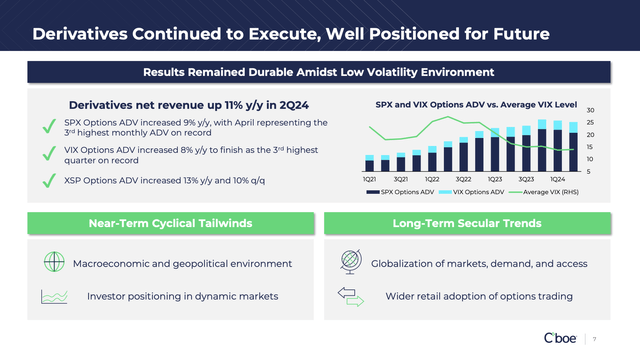
What’s interesting to notice is that the company has shifted focus from mergers and acquisitions to organic growth, benefitting from its existing capabilities that were expanded through M&A in the past.
As I already briefly mentioned, this includes refocusing efforts on digital asset derivatives and its technology infrastructure.
Essentially, the company makes the case that by investing in its global technology platform, it can enhance trading experiences and expand market access, especially in the Asia Pacific region, where demand for U.S. market exposure is growing.
Cboe Global Markets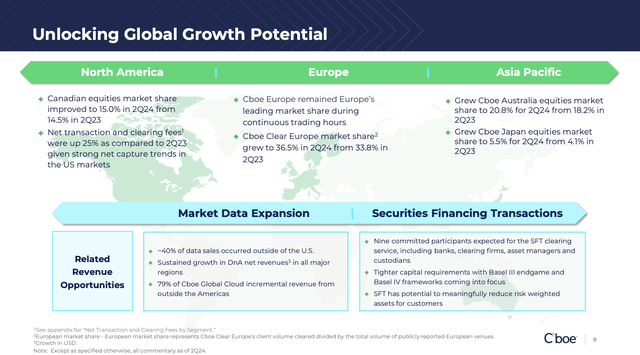
So far, Cboe’s global expansion strategy has positioned it as a key player in importing U.S. market opportunities to international investors and exporting its exchange technology and data.
These efforts include the expansion of SPX options in regions like Hong Kong, Thailand, And South Korea, allowing investors in these nations to get better access to the U.S. market.
Moreover, the company’s European Derivatives platform, called CEDX, successfully launched its first equity options trade. The company also made significant progress in tightening spreads and improving liquidity in European markets.
As we can see below, the U.S. equity and index options market is 17x larger than the Pan-European market!
Cboe Global Markets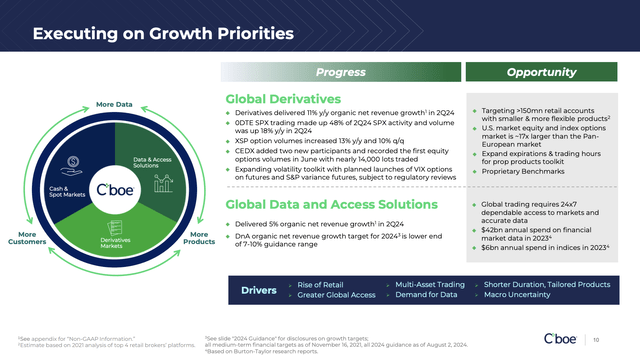
Meanwhile, the Data and Access Solutions isn’t doing poorly, either.
Despite a tough comparison quarter, revenues in this segment rose by 5%, supported by the launch of new products, including Dedicated Cores, which improves exchange access and reduces latency.
Moreover, 40% of growth in this segment came from the U.S.
Cboe Global Markets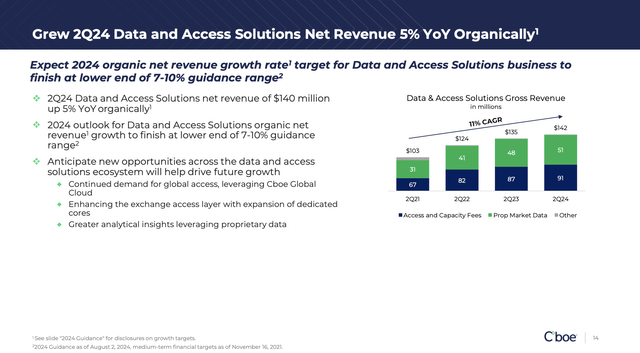
Personally, I’m impressed by these numbers. Not only because they indicate strong growth, but also because this happened during a period when volatility was very low.
This bodes well for future growth and shareholder distributions.
Shareholder Distributions & Valuation
In the second quarter, Cboe bought back $90 million worth of shares, bringing the total for the first half of 2024 to $180 million. Over the past ten years, Cboe has bought back 1.4% of its shares. That’s not a lot.
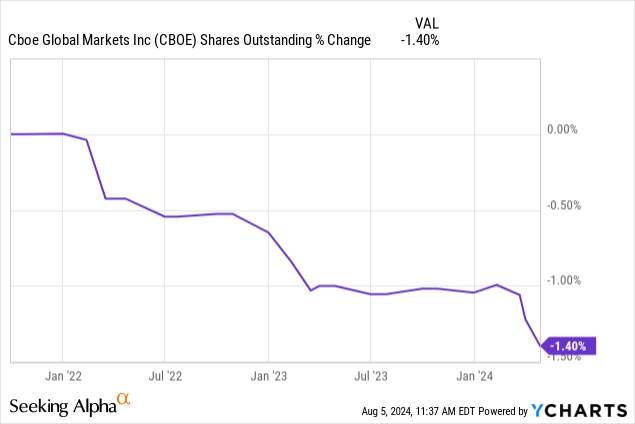
The good news is that buybacks are likely to get more aggressive as the company is focusing on organic growth instead of M&A. It also helps that is has a very healthy balance sheet with a 1.1x leverage ratio.
Additionally, the company returned $58.2 million to shareholders through a $0.55 per share quarterly dividend. The last time this dividend was hiked was on August 16, 2023, when the company hiked by 10%.
The dividend has a five-year CAGR of 12.1% and a payout ratio of just 26%. CBOE yields 1.1%.

Overall, the company returned nearly $300 million to shareholders in the first half of 2024, which translates to 65% of its adjusted earnings.
In other words, there’s a lot of room for dividend growth and buybacks – especially given the company’s focus on organic growth.
The only reason it has a yield of just 1.1% is because capital gains have offset dividend growth. Over the past ten years, CBOE has returned 352%, much more than the already impressive 229% return of the S&P 500.

Going forward, we can expect growth to remain elevated.
On a full-year basis, the company expects 7% to 10% organic growth in its Data and Access Solutions business and at least 6% total organic revenue growth.
Cboe Global Markets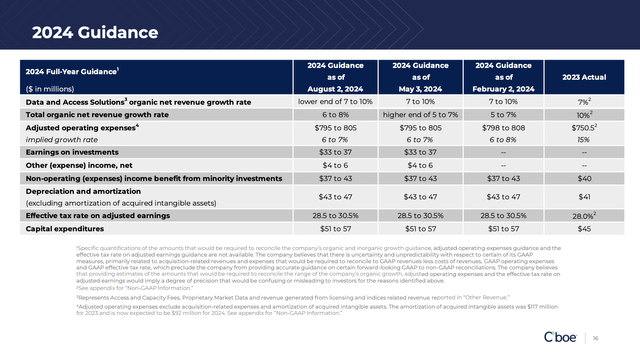
Speaking of expectations, using the FactSet data in the chart below, CBOE is expected to grow its EPS by 6-9% per year through at least 2026. I expect actual growth rates to come in higher, especially if we get higher volatility.
FAST Graphs
That said, with a blended P/E ratio of 23.6x, the stock trades slightly above its long-term normalized P/E ratio of 23.0x.
This implies an annual return of 7-10%, including its 1.1% dividend yield.
As such, I remain bullish and believe the company is in a great spot to beat the market on a prolonged basis.
Takeaway
In a volatile market, some companies thrive. Cboe Global Markets is one of them.
Despite recent market turbulence, Cboe’s robust performance underscores its resilience and growth potential.
With strong revenue growth and impressive growth in key segments like SPX options and VIX futures, it’s fair to say that Cboe’s strategy shift from M&A to organic growth is paying off.
Meanwhile, the company’s global expansion and focus on enhancing technology infrastructure position it as a major player in connecting international investors to U.S. markets.
With a commitment to shareholder returns through dividends and buybacks, Cboe remains a top pick for long-term growth and stability.
Pros & Cons
Pros:
- Strong Growth Potential: CBOE is capitalizing on market volatility, driving impressive growth in trading volumes, especially with products like SPX options and VIX futures.
- Global Expansion: The company’s strategic focus on international markets and digital assets is expanding its revenue base and opening new opportunities.
- Consistent Shareholder Returns: With increasing buybacks and a consistently growing dividend, CBOE continues to reward shareholders.
- Resilient Business Model: CBOE benefits from high volatility, making it a great hedge in times of volatility.
Cons:
- Dependence on Market Volatility: While high volatility benefits CBOE, periods of low volatility could slow growth and impact revenues. However, its expansion into services lowers these risks.
- Competitive Industry: CBOE operates in a highly competitive industry. This requires constant innovation to maintain its market share.
Read the full article here











